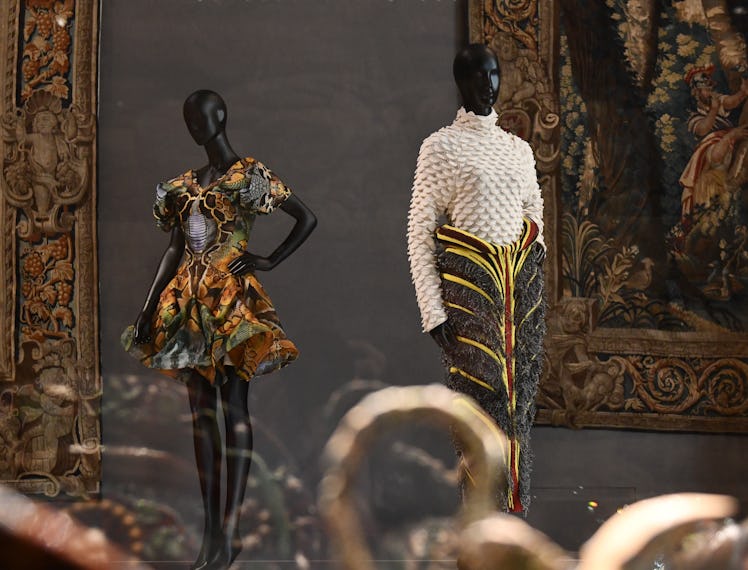
The Louvre is the world’s most famous museum, with an encyclopedic collection of more than 500,000 paintings, drawings, archaeological finds, and objets d’art spanning millennia. Yet with the exception of sumptuous mantles of the chivalric Order of the Holy Spirit that were restored last year, the French cultural institution holds no clothing in its permanent collection, and has never presented a multigallery fashion exhibition—until now. Louvre Couture: Art and Fashion: Statement Pieces, which opens January 24, brings together more than 100 different looks and accessories from 45 maisons and designers, ranging from Cristóbal Balenciaga to Marine Serre, showcasing the close relationship between contemporary fashion and decorative arts.
“The impression that I would like people to take from this exhibition is the fact that museums are very free and contemporary places,” says Olivier Gabet, the Louvre’s senior heritage curator and director of the Department of Decorative Arts. “I wanted to show that what can seem at first sight like a dusty collection, can be absolutely modern in terms of inspiration.” Gabet brings a deep knowledge of fashion from the blockbuster fashion shows like Christian Dior: Couturier du Rêves that he organized at Musée des Arts Décoratifs, where he previously served as director before joining the Louvre in 2022. In his estimation, the Louvre is a “vast mood board,” a source of endless inspirations and influences for contemporary designers and fashion lovers.
A Balenciaga look interacts with the Louvre’s rococo interior.
Encompassing four key historical periods—Byzantium and the Middle Ages, the Renaissance, the Grand Siècle and eighteenth century, and the nineteenth century—Louvre Couture is spread across the museum, from the decorative arts galleries in the Richelieu and Sully Wings to the Napoleon III apartments, placing fashion pieces created between 1960 and 2025 in conversation with historical furniture and objets d’art that inspired them. Sometimes the inspiration is quite literal—as in the case of Karl Lagerfeld’s Chanel haute couture spring 2019 skirt suit with an all-over blue-and-white paillette embroidered motif inspired by an 18th-century lacquered chest of drawers in the Louvre’s collection that once belonged to Louise Julie de Mailly-Nesle, comtesse de Mailly. Others are more abstract, like Nadège Vanhée’s Hèrmes spring 2021 geometric bronze mesh-covered stretch silk minidress that takes cues from medieval chainmail.
Looks from Chanel and Undercover.
The 18th-century period rooms are the most densely populated, featuring rococo-inspired looks by Christian Dior, Yves Saint Laurent, Alexander McQueen, John Galliano, and Nicolas Ghesquière that resemble the marquetry and gold scrolls seen nearby on Boulle cabinets and Louis XV chairs. Gabet traces fashion’s enduring fascination with the 18th-century to such OG tastemakers as Madame de Pompadour, Madame du Berry, and, of course, Queen Marie Antoinette. “It was a moment of excellence in craft. You had these strong female figures who embodied a certain vision of fashion,” says Gabet. “From the 18th century until today it has been an enduring thread of inspiration and fantasy.”
A look from Chloé.
Looks from Paco Rabanne, Balenciaga, Loewe and Gareth Pugh.
Looks from Duro Olowu and Loewe.
The exhibition also features more subdued designs from Balencaiga and Carven, two houses whose founders were passionate collectors of 18th-century decorative arts but who have nevertheless resisted rococo flourishes in their own work. Demna’s almost ascetic sculptural black ball gown, which debuted on the Balenciaga spring 2020 runway, mirrors the way Cristóbal Balenciaga’s sculptural midcentury shapes resembled spaceships. Similarly Louise Trotter’s Carven spring 2025 raw-edge satin coat echoes the minimalism of Marie-Louise Carven, who was known both for her sharply tailored monochrome dresses and for donating more than 100 pieces of 18th-century furniture and objets d’art from her personal collection to the Louvre.
Looks from Schiaparelli, Iris Van Herpen, Hermès and Loewe.
If the exhibition’s opening day is any indication, the fresh way of seeing the Louvre’s decorative arts collection is already attracting new visitors. “What I love is that there is a younger crowd here today,” says Gabet. “The galleries of the Decorative Art department are not always the most popular when you have Archeology and the Mona Lisa.”